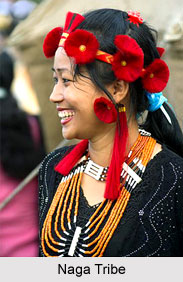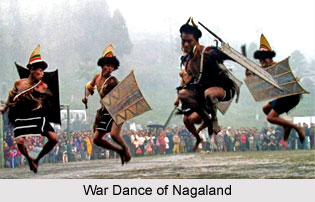 Nagaland is one of the north east states of India. With the fume of the flowers that dance to the tune of the tribal lyre, with the verve of fiestas and with the simplicity of the Naga people, Nagaland weaves the quilt of dream and romance which has captivated all since the remote past. It shares its border with Myanmar, Arunachal Pradesh and Assam. Nagaland is physically at the very extremity of the subcontinent. The capital of Nagaland is Kohima.
Nagaland is one of the north east states of India. With the fume of the flowers that dance to the tune of the tribal lyre, with the verve of fiestas and with the simplicity of the Naga people, Nagaland weaves the quilt of dream and romance which has captivated all since the remote past. It shares its border with Myanmar, Arunachal Pradesh and Assam. Nagaland is physically at the very extremity of the subcontinent. The capital of Nagaland is Kohima.
History of Nagaland
The Naga tribes had socio-economic and political links with tribes in Assam and Myanmar. In 1816 Nagaland along with Assam came under the direct rule of Myanmar, which was a period of oppression and turmoil. When the East India Company took control of Assam in 1826, they extended their domain over modern Nagaland. By 1892, all of modern Nagaland except the Tuensang area was governed by the British. It was amalgamated with Assam. After the independence, the area remained a part of the province of Assam.
Nagaland was constituted on 25th January 1950, a day before India became a Republic. On August 21, 1962 the then Prime Minister Pandit Jawaharlal Nehru introduced a Bill in the Parliament for the formation of Nagaland as a complete State. The Act provided for the formulation of the state of Nagaland as the 16th state in the Indian Union, and on December 1, 1963, President Dr. S. Radhakrishnan inaugurated the state of Nagaland.

Geography of Nagaland
Nagaland is spread over an area of 16,527 square kilometres. The Naga Hills can be seen rising from the Brahmaputra Valley in Assam. It is as high as 6,000 feet. The state`s highest peak is Mount Sabarmati, where the Naga Hills merge with the Patkai Range in Myanmar. The rivers as Doyang and Dikku in the North, the Barak River in the southwest and the Chindwin River (of Mayanmar) in the southeast dissect the state. Nagaland has a largely monsoon climate with high humidity levels. In winter, temperatures do not drop below 39 degrees but frost is common at high elevations.
Demography of Nagaland
According to the 2011 census, the population of Nagaland is 1,98,0602. The state has the density of 119 persons per square kilometre. There are 11 districts and 1278 villages. Female literacy of the state is 76.69 percent and the male literacy is 83.29 percent. There are many distinct tribes and a number of sub-tribes inhabiting the area such as Angamis, Zeliangs, Rengmas, Kukis, Semas, Aos, Lothas, Chang, Sangtam and Koyaks.

Culture of Nagaland
The different tribes of Nagaland are Angami, Ao, Chakhesang (Chokri/Kheza), Chang, Khiamniungan, Kuki, Konyak, Lotha, Phom, Pochury, Rengma, Sumi, Sangtam, Yimchungru, Tangkhul and Zeliang. More than 80 percent of the people live in rural areas. The Angamis, Aos, Konyaks and Semas are the largest Naga tribes. Weaving is the traditional art of the people which was handed down from generations. Tribal dances of the Nagas give an insight into their inborn reticence. War dances belonging to the different tribes are a major art form in Nagaland. They speak 60 different dialects belonging to the Sino-Tibetan family of languages. Nagamese, a variant language form of Assamese and Hindi is the most widely spoken language. One interesting trait of them is that each tribe has their own mother tongue and these tribes communicate with each other in Nagamese.
Education in Nagaland
The people of Nagaland are aware of the role of education but the slow pace of socio-economic changes is unable to cater to their emerging aspirations. Administrative Training Institute, Kohima is the top training Institute in the state of Nagaland. It was established in 1972 with the objective to update and enhance professional knowledge and skills needed for better performance of individuals and to promote better understanding of professional requirements and bringing about the right attitudinal orientation.
Administration in Nagaland
The Raj Bhavan is the seat of the Constitutional Head of the state. Nagaland came into existence on 1st December 1963. It is the sixteenth state in the country. The Commissioner`s house was selected as the Raj Bhavan when Shri Vishnu Sahay was the Governor of Assam and Nagaland. When Dr. Gopal Singh took over as the Governor of the state, he took up the reconstruction of the Raj Bhavan. At present there are three political parties at Nagaland. They are Naga National Democratic Party is a regional political party in Nagaland, India. The party was founded in 1964. Nagaland Democratic Party (NDP) is a political party of Nagaland which was founded on 1999. The convenor of the party was Roland Lotha. In the State Assembly Elections of 2003, NDP contested as part of the NPF- led Democratic Alliance of Nagaland. On March 22, 2004 NDP merged with Nagaland People`s Front. Nagaland People`s Front leads the State Government of Nagaland with the BJP, as part of the Democratic Alliance of Nagaland. Nagaland has eight administrative districts namely Dimapur, Kohima, Mokokchung, Mon, Phek, Tuensang, Wokha and Zunheboto.

Economy of Nagaland
The most important economy of Nagaland is agriculture. Seventy percent of the population depend on agriculture. The major crops are rice, corn, millets, pulses, tobacco, oilseeds, sugarcane, potatoes and fibres. Rice is the dominant crop and also the staple diet of the people. Oil seeds like rapeseed and mustard are grown in wide areas. Coffee, cardamom and tea are grown as plantation crops in Nagaland. Principal crops are Arums, yams, millet, maize, potatoes and sugarcane. The important vegetables are melon, cucumbers, spinach leaf, mustard, onion, chillies, carrots, tomatoes and brinjal. The two methods of cultivation among the Naga tribes are jhumming and terrace cultivation. The Government is encouraging to improve the agriculture and has under taken a number of irrigation projects like supplying pumping set to farmers, starting community development projects, setting up seed farms and establishing agricultural research centres. Forestry is an important source of income. Cottage industries such as weaving, woodwork and pottery are important sources of revenue.
Tourism in Nagaland
Nagaland serves as one of the most enchant tourist places offering diverse experiences to the visitors. Pilgrimage tourism of the state includes a number of cathedral and churches. Nature tourism is immensely pleasing in Nagaland with a number of exotic waterfalls, zoological parks and places having scenic beauty. A number of adventurous activities can be enjoyed in Nagaland. Tribal and folk lifestyles of Nagaland are also worth experiencing.



















